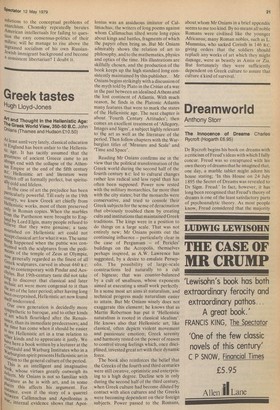Greek tastes
Hugh Lloyd-Jones
!In and Thought in the Hellenistic Age: _ma Greek World View, 350-50 B.C. John unians (Thames and Hudson £10.50) At least until very lately, classical education i!lEngland has been unfair to the Hellenistic age. It has tacitly assumed that the greatness of ancient Greece came to an a. bruin end with the collapse of the Athenian Empire at the end of the fifth century RC; Hellenistic art and literature were wntten off as formally perfect, but spirituallY cold and lifeless.
In the case of art the prejudice has been Particularly powerful. Till early in the 19th e,..entury, we knew Greek art chiefly from rlellenistic works, most of them preserved ZillY in Roman copies. When the marbles iueln the Parthenon were brought to EngLanSI by Lord Elgin, many people refused to uelieve that they were genuine; a taste 11Nrished on Hellenistic art could not takee.ePt classical art for what it was. The same ;ling happened when the public was conlonted with the sculptures from the pediitih ents of the temple of Zeus at Olympia, generally regarded as the finest of all reek sculptures, carved in about 460 B.C. r,kricl so contemporary with Pindar and Aes',illus. But 19th-century taste did not take ,(4ig to discover that classical and later :relleic art were more congenial to it than tblite art of the later period; after having long 1en overpraised, Hellenistic art now found t3elf underrated. s Our own generation is decidedly more „YrnPathetic to baroque, and to other kinds `s1 art which flourished after the Renaisince, than its immediate predecessors; and tile time has come when it should be easier see Hellenistic art in a true relation to uhther kinds and to appreciate it justly. We f,a_ve here a book written by a lecturer at the Ourtauld and Warburg Institutes who in a 17arburgian spirit presents Hellenistic art in Onto the general culture of the period. this is an intelligent and imaginative d ?it, whose virtues greatly outweigh its ects. Mr Onians is not so familiar with olerature as he is with art, and in some i aces this affects his argument. For tZtance, even if the story of a quarrel ih,tvveen Callimachus and Apollonius is -'1e, internal evidence shows that Apol lonius was an assiduous imitator of Callimachus; the writers of long poems against whom Callimachus tilted wrote long epics about kings and battles, fragments of which the papyri often bring us. But Mr Onians admirably shows the relation of art to philosophy, and to the mathematics, physics and optics of the time. His illustrations are skilfully chosen, and the production of the book keeps up the high standard long consistently maintained by this publisher. Mr Onians begins strikingly with a discussion of the myth told by Plato in the Critias of a war in the past between an idealised Athens and the lost continent of Atlantis. With much reason, he finds in the Platonic Atlantis many features that were to mark the states of the Hellenistic age. The next chapter is about 'Fourth Century Attitudes'; then comes an excellent treatment of 'Allegory, Images and Signs', a subject highly relevant to the art as well as the literature of the period. Then follow chapters with the Warburgian titles of 'Measure and Scale' and 'Time and Space'.
Reading Mr Onians confirms me in the view that the political transformation of the Greek world during the second half of the fourth century B.C. led to cultural changes rather less radical and less rapid than has often been supposed. Power now rested with the military monarchies, far more than with the city states; but the monarchs were conservative, and tried to console their Greek subjects for the sense of deracination that obviously troubled them by creating cults and institutions that maintained Greek traditions. The kings were in a position to do things on a large scale. That was not entirely new; Mr Onians points out the continuing influence — particularly clear in the case of Pergamum — of Pericles' buildings on the Acropolis, themselves perhaps inspired, as A.W. Lawrence has suggested, by a desire to emulate Persepolis. The possibility of large-scale constructions led naturally to a cult of bigness; that was counter-balanced by a cult of smallness, whose exponents aimed at executing a small work perfectly.
In a sense most art aims it naturalism, and technical progress made naturalism easier to attain. But Mr Onians wisely does not exaggerate this element; he knows that as Martin Robertson has put it 'Hellenistic naturalism is rooted in classical idealism'.
He knows also that Hellenistic art, like classical, often depicts violent movement and passionate emotion; Greek serenity and harmony rested on the power of reason to control strong feelings which, once disciplined, invested great art with their dynamic force.
The book also reinforces the belief that the Greeks of the fourth and third centuries were still Creative, optimistic and enterpris ing to a high degree. Decline sets in only during the second half of the third century, when Greek culture had become diluted by contact with alien cultures and the Greeks were becoming dependent on their foreign subjects. Power passed to the Romans, about.whom Mr Onians in a brief appendix seems to me too kind. By no means all noble Romans were civilised like the younger Africanus; many Roman nobles, such as L. Mununius, who sacked Corinth in 146 B.C., giving orders that the soldiers should replace any works of art which they might damage, were as beastly as Amin or Zia. But fortunately they were sufficiently dependent on Greek culture to assure that culture a-kind of survival.


































 Previous page
Previous page